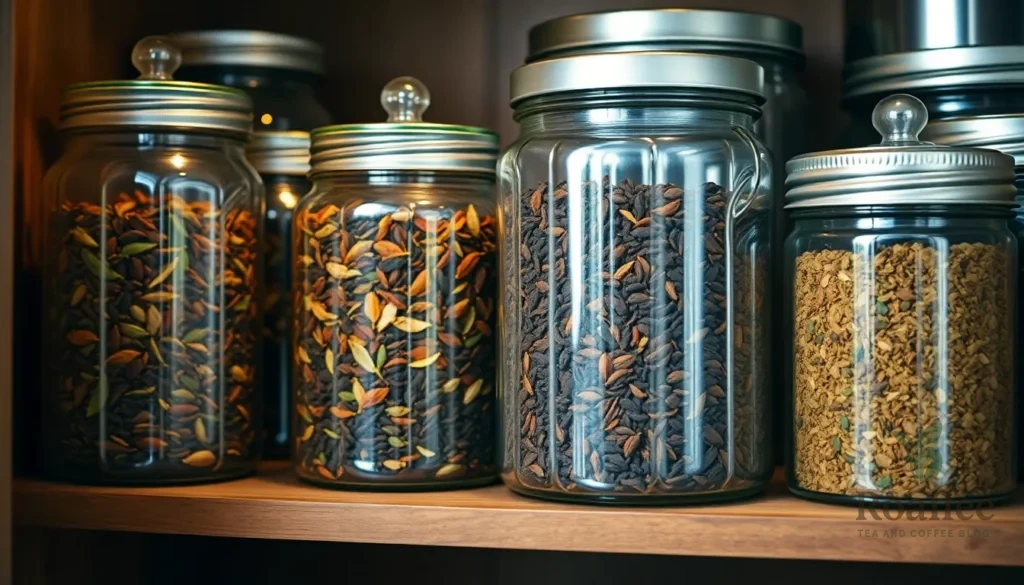We’ve all been there – splurging on premium loose leaf tea only to watch it lose its vibrant flavor and aroma within weeks. Proper storage isn’t just about keeping your tea fresh; it’s about preserving the investment you’ve made in quality ingredients that can transform your daily tea ritual into something extraordinary.
The difference between well-stored and poorly stored loose leaf tea is dramatic. When we protect our tea from light, air, moisture, and strong odors, we’re essentially locking in the complex flavors and beneficial compounds that make each cup a delightful experience. Poor storage can turn even the finest Ceylon or Earl Grey into a disappointing, flat-tasting brew.
Whether you’re a casual tea drinker or a serious enthusiast, understanding the fundamentals of tea storage will help you get the most value from every purchase. We’ll walk you through the essential techniques that keep your loose leaf tea tasting as fresh as the day you bought it.
Essential Storage Containers for Loose Leaf Tea
The right storage container makes all the difference in preserving your tea’s quality and extending its shelf life. We’ll explore the most effective options that protect against the four main enemies of tea freshness.
Airtight Glass Jars
Glass jars provide excellent visibility while maintaining an airtight seal that keeps moisture and air out. We recommend choosing dark-colored glass or storing clear jars in dark cabinets since light exposure can degrade tea compounds over time. Mason jars work particularly well for this purpose due to their reliable sealing mechanism and wide mouth opening that makes tea access easy.
The non-porous nature of glass prevents flavor absorption from previous contents. This quality makes glass jars ideal for storing different tea varieties without worrying about flavor contamination. We suggest selecting jars with rubber gaskets or silicone seals for maximum air protection.
Tin Canisters
Tin canisters offer superior protection against light while maintaining airtight conditions that preserve tea freshness. We find that quality tin containers with tight-fitting lids create an excellent barrier against moisture and air infiltration. Many specialty tea retailers use tin canisters because they block harmful UV rays completely.
The metal construction provides durability and stackability for organized storage. We recommend choosing tins with inner lids or double-wall construction for enhanced protection. Food-grade tin canisters prevent any metallic taste transfer while maintaining optimal storage conditions.
Vacuum-Sealed Bags
Vacuum-sealed bags remove air completely and create the most airtight storage environment possible. We use these bags for long-term storage of tea purchases or when storing seasonal teas for extended periods. The vacuum process eliminates oxygen that can cause tea deterioration over time.
These bags work exceptionally well for bulk tea storage and travel purposes. We suggest using opaque vacuum bags or storing sealed bags in dark locations to prevent light exposure. Double-bagging provides extra protection for particularly valuable or delicate tea varieties.
What to Avoid
Cardboard boxes allow air and moisture penetration that rapidly degrades tea quality. We never recommend storing tea in original paper packaging for extended periods since these materials offer minimal protection against environmental factors.
Plastic containers can absorb and transfer odors that contaminate tea flavors. We avoid clear plastic storage since it provides no UV protection and can develop static that attracts dust particles. Metal containers without proper food-grade lining may impart metallic tastes to delicate tea varieties.
Optimal Storage Conditions
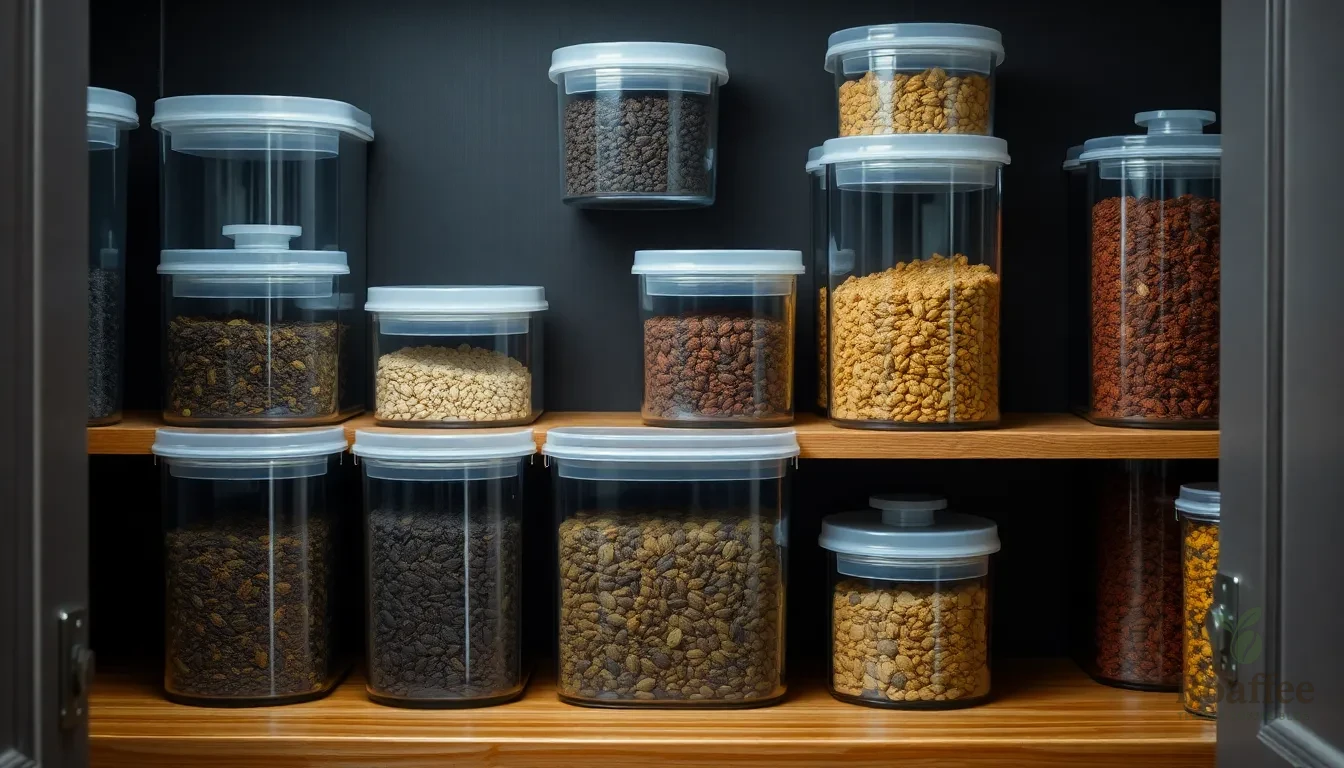
Creating the perfect environment for your loose leaf tea extends far beyond selecting the right container. We must carefully control several environmental factors to preserve the delicate compounds that give tea its distinctive flavor and aroma.
Temperature Requirements
Temperature stability plays a crucial role in maintaining tea quality over time. We recommend storing your loose leaf tea in a cool location where temperatures remain between 60°F to 75°F (15°C to 24°C). This temperature range prevents the acceleration of chemical reactions that can degrade flavor compounds.
Avoid areas where temperature fluctuations occur frequently, as these changes can cause condensation to form inside containers and spoil your tea. Kitchen pantries near stoves or areas with heating vents create unstable conditions that compromise tea freshness. Some delicate varieties like green and yellow teas may benefit from refrigeration or freezing, though this approach requires careful management to prevent condensation damage when removing containers from cold storage.
Humidity Control
Moisture control stands as one of the most critical factors in tea storage success. We must keep our loose leaf tea in a dry environment to prevent mold growth and flavor deterioration. Kitchens and bathrooms present particularly challenging environments due to their fluctuating humidity levels from cooking steam and shower moisture.
Excess moisture proves detrimental to most tea types, breaking down essential oils and creating conditions for spoilage. Even specialty teas like Pu-erh, which require some air exposure for proper aging, must be kept away from high moisture environments to maintain their intended flavor profiles.
Light Protection
Light exposure represents a important threat to tea quality, as it breaks down the delicate flavor compounds that make each variety unique. We need to store our tea away from direct sunlight and any bright artificial lighting that can penetrate storage containers.
Opaque containers provide the best protection against light damage, which is why we emphasize avoiding clear glass containers even though their visual appeal. UV rays and bright light accelerate the degradation process, turning vibrant tea leaves dull and reducing their flavor intensity over time.
Air Circulation
Managing air exposure requires a delicate balance between preventing oxidation and avoiding stagnant conditions. We minimize air contact by using containers with tight seals that limit oxygen exposure, which causes gradual flavor degradation through oxidation processes.
Large containers that leave excess air space around tea leaves create unnecessary exposure risks. Choose appropriately sized containers that minimize the air-to-tea ratio, ensuring your leaves remain protected while avoiding the compression that can damage delicate tea structures.
Storage Location Guidelines

After selecting the right containers and understanding optimal storage conditions, we need to identify the best locations in our homes for storing loose leaf tea. The placement of our tea storage directly impacts how well we preserve its delicate flavors and aromas.
Best Places to Store Tea
We recommend storing loose leaf tea in cool, dry, and dark places such as pantries, cupboards, or cabinets that remain away from direct sunlight and heat sources. These locations provide the stable environment our tea needs to maintain its quality over time.
Kitchen cabinets positioned away from the stove offer excellent storage opportunities since they shield tea from temperature fluctuations. Pantries work exceptionally well because they typically maintain consistent cool temperatures while protecting contents from light exposure.
Bedroom closets or spare room storage areas can serve as alternative locations when kitchen space is limited. We should ensure these areas remain dry and free from strong odors that might compromise our tea’s flavor profile.
Areas to Avoid
We must avoid storing loose leaf tea near heat sources such as stoves, ovens, or heating vents since these locations cause rapid quality degradation. Direct sunlight exposure through windows breaks down flavor compounds and diminishes the tea’s essential characteristics.
High humidity areas like bathrooms or basements create moisture problems that lead to mold growth and spoilage. We should never place tea storage containers in these damp environments.
Strong-smelling foods or spices pose another storage hazard because tea absorbs odors easily. Keeping tea away from garlic, onions, coffee, or cleaning supplies prevents unwanted flavor contamination.
Window sills might seem convenient but expose tea to both light and temperature variations throughout the day. We recommend avoiding any location where temperature and light conditions fluctuate regularly.
Pantry vs. Refrigerator Debate
Pantry or cupboard storage is generally best for maintaining tea freshness since these locations provide stable, cool, and dry environments without moisture risks. We find that room temperature storage in proper containers preserves tea quality more effectively than refrigeration.
Refrigerating tea creates condensation and moisture changes when we remove containers from cold storage, potentially causing spoilage. The temperature fluctuations between cold refrigerator air and warm room air can damage delicate tea leaves.
| Storage Method | Temperature Stability | Moisture Risk | Convenience |
|---|---|---|---|
| Pantry/Cupboard | High | Low | High |
| Refrigerator | Low | High | Low |
The only exception applies to large quantities of green tea that will take over six months to consume. In these cases, refrigeration can help extend freshness but requires careful moisture control and sealed containers to prevent condensation damage.
We always prefer pantry storage because it eliminates the risk of moisture exposure while maintaining the consistent environment our tea requires for optimal preservation.
Organizing Different Tea Types
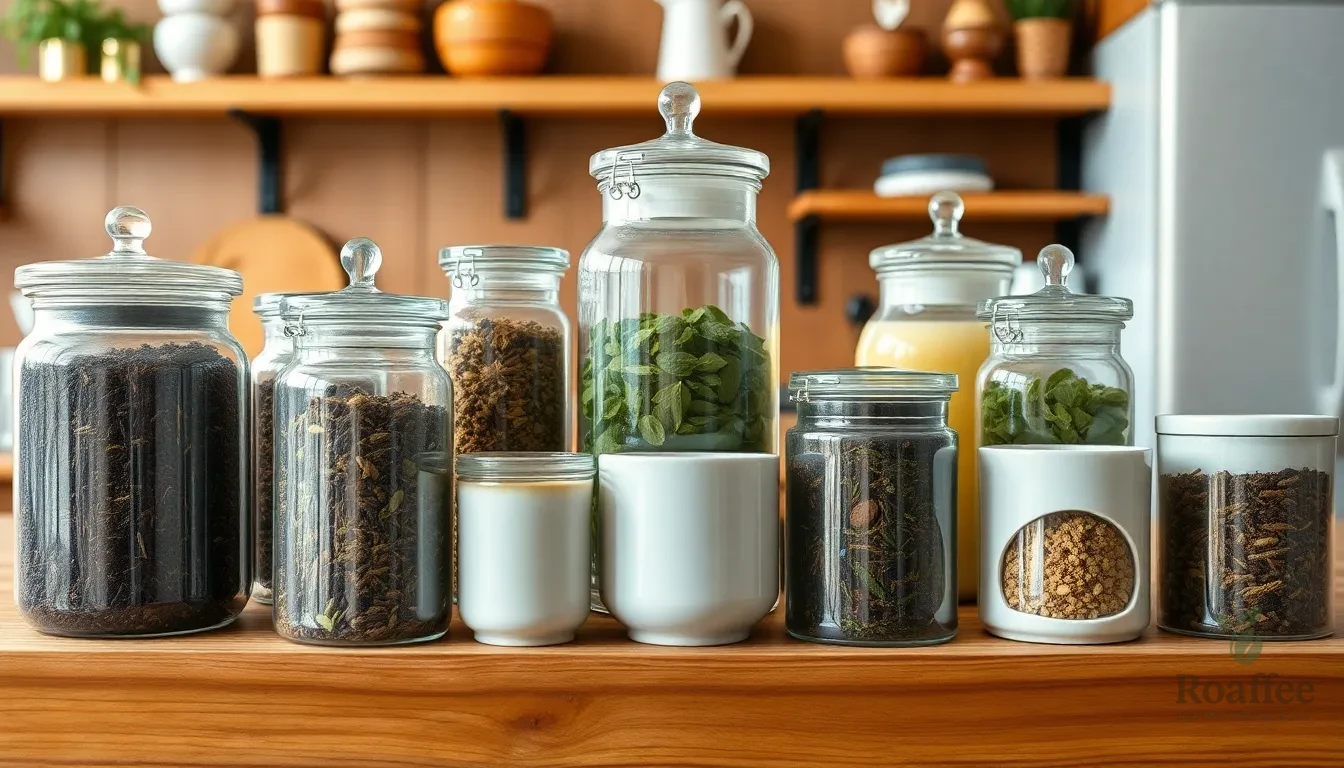
We organize our loose leaf tea collection by type and oxidation level since different teas have varying sensitivities to environmental factors. This systematic approach ensures each variety receives the exact care it needs to maintain optimal flavor and aroma.
Separating Black, Green, and Herbal Teas
Black teas demonstrate the highest resilience among all tea types due to their full oxidation process. We can store these robust teas with confidence knowing they retain their bold flavors longer than their delicate counterparts. Their oxidized nature makes them less susceptible to environmental changes.
Green and white teas require our most careful attention as their minimal processing leaves them highly sensitive to light and temperature fluctuations. We store these delicate varieties in cooler and darker conditions to prevent the rapid flavor loss that occurs when exposed to heat or bright light. Their fresh and subtle characteristics demand protection from any harsh storage conditions.
Oolong teas occupy the middle ground between black and green varieties in terms of storage requirements. We treat these partially oxidized teas with moderate care while ensuring they receive protection from continued oxidation exposure. Their complex flavor profiles benefit from stable storage conditions that preserve their unique balance.
Herbal teas present unique storage challenges due to their high absorbency and diverse ingredient compositions. We keep these blends in completely sealed and odor proof containers because their spices and fruits readily absorb surrounding aromas. Their botanical nature makes them particularly vulnerable to flavor contamination from nearby items.
Preventing Flavor Cross-Contamination
We use individual airtight and odor free containers for each tea type to maintain their distinct flavor profiles. Ceramic canisters and stainless steel containers provide excellent barriers against unwanted odors while dark glass options offer additional light protection. These materials ensure our teas remain pure and uncontaminated.
Plastic containers and clear jars create problems by potentially leaking odors or allowing damaging light exposure. We avoid these materials entirely when storing our premium loose leaf teas. The investment in proper storage containers pays dividends in preserved tea quality over time.
Storage location plays a crucial role in preventing cross contamination. We position our tea containers away from strong smelling foods and aromatic cooking ingredients. Spices and coffee can easily transfer their intense aromas to nearby tea storage areas.
When purchasing tea in bulk quantities we divide larger amounts into smaller containers and only open what we need for immediate use. This practice minimizes air exposure for the remaining tea while maintaining freshness across our entire collection.
Labeling and Dating System
We label each container with the exact tea type and the date we received or first opened the package. This systematic approach helps us track freshness levels and encourages consumption before flavor deterioration occurs. Clear labeling eliminates guesswork when selecting teas from our collection.
Our dating system enables us to rotate stock effectively and use older teas before newer purchases. We write dates prominently on container lids or sides using permanent markers that won’t fade over time. This visibility ensures we never overlook aging inventory.
Original foil packaging provides an additional freshness barrier when kept inside our storage canisters. We bundle these inner packages tightly after opening to create extra protection against air exposure. This double layer approach maximizes preservation effectiveness for our most valuable tea varieties.
Long-Term Storage Strategies
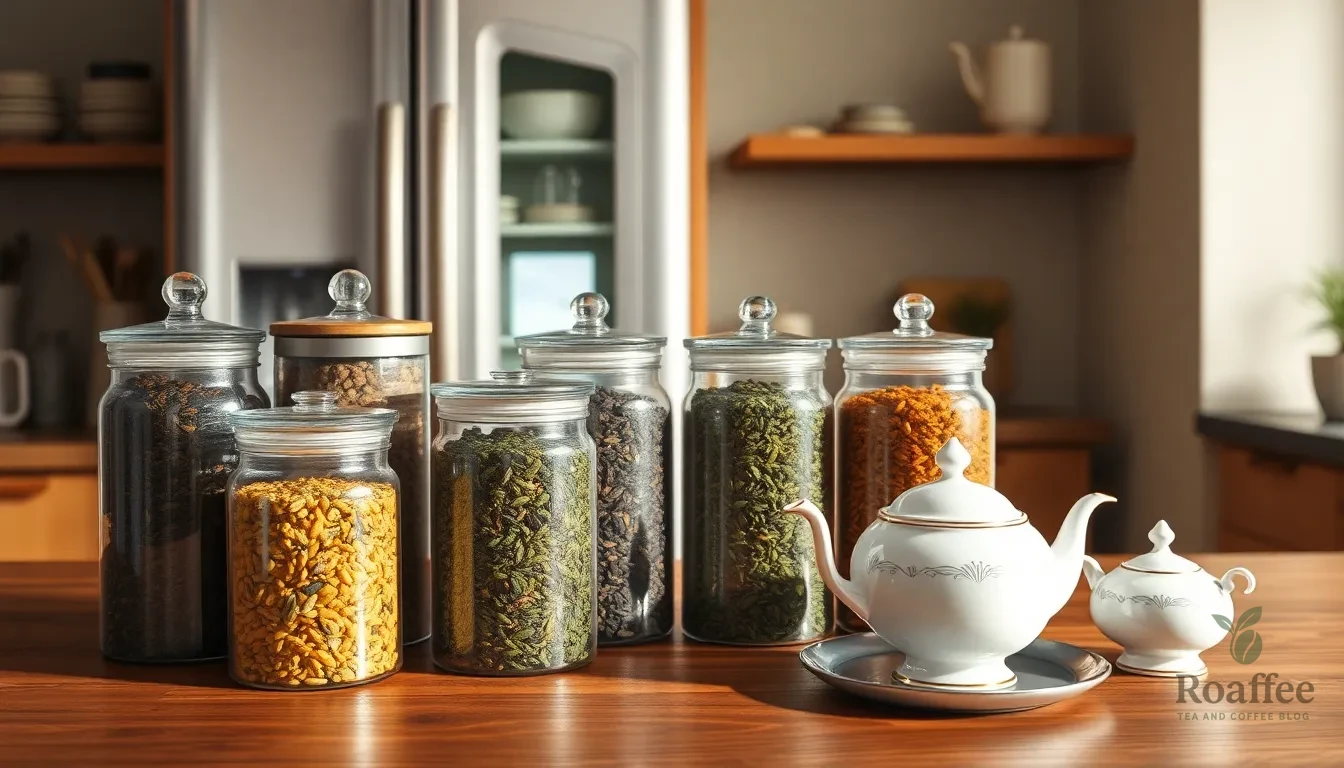
When we plan to store loose leaf tea for extended periods, we need specialized approaches that maintain quality over months or years. These strategies go beyond basic storage to ensure our tea investment remains valuable and flavorful over time.
Bulk Tea Storage
For larger quantities of loose leaf tea, we recommend keeping the tea in its original foil-lined packaging with the seal tightly closed. This approach provides the first line of defense against air exposure and moisture infiltration. We then transfer smaller portions to daily-use canisters, which prevents repeatedly opening the bulk storage and exposing the entire supply to air.
When storing substantial amounts of green tea, refrigeration becomes a viable option for extending shelf life. But, we must ensure the tea is packaged in completely airtight containers to prevent moisture and odor contamination during storage. This method works particularly well for delicate green varieties that we plan to consume over six months or longer.
Pu-erh tea presents a unique exception to standard storage rules. We allow this fermented tea slight air exposure and variable temperatures because these conditions actually benefit the aging process that enhances its character and flavor profile over time.
Freezing Loose Leaf Tea
Freezing offers an excellent preservation method for delicate green and yellow teas by dramatically slowing the oxidation process. We must vacuum seal or use completely airtight containers before freezing to prevent moisture damage during the thawing process. This technique proves particularly valuable for expensive or rare teas that we want to preserve at peak freshness.
Temperature stability becomes crucial when using freezer storage. We avoid repeated temperature changes that can degrade tea quality through condensation and thermal shock. Once we remove tea from the freezer, we allow it to reach room temperature before opening the container to prevent moisture condensation on the leaves.
Rotation Methods
We carry out a first-in, first-out system to ensure older tea gets consumed before newer stock. This rotation method prevents tea from sitting unused for extended periods while fresher supplies get depleted first. We find this approach particularly important for maintaining consistent quality across our tea collection.
Regular date checking becomes essential for effective rotation. We label containers with purchase dates and regularly review these labels to consume tea while it remains fresh. This systematic approach helps us avoid long-term degradation and ensures we experience our tea at its optimal flavor profile.
The combination of proper rotation with our storage techniques maximizes the lifespan of our loose leaf tea collection while maintaining the highest quality standards.
Signs Your Tea Has Gone Bad
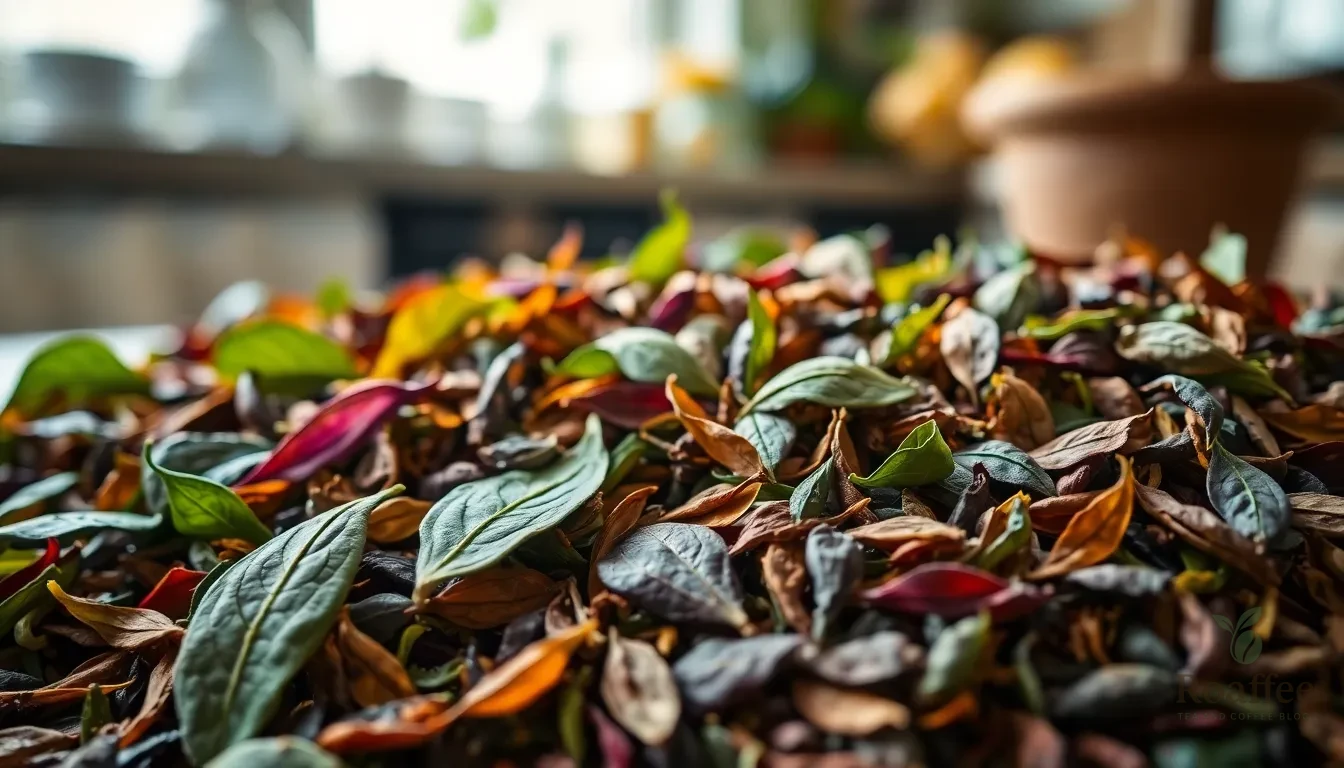
Even with perfect storage conditions, we need to regularly check our loose leaf tea for signs of deterioration. Recognizing these warning signs helps us maintain the quality of our collection and avoid disappointing brews.
Visual Indicators
We can identify spoiled tea through several clear visual cues that indicate moisture damage or contamination. Faded color is often the first sign we notice, as fresh tea leaves maintain vibrant hues that gradually diminish over time.
Mold growth presents the most serious visual warning, appearing as fuzzy patches or white spots scattered across the leaves. These growths indicate moisture has compromised the tea’s integrity and poses health risks if consumed.
Clumped leaves signal that humidity has caused the tea to stick together, creating dense clusters instead of the loose, individual leaves we expect. This clumping often accompanies other deterioration signs and suggests the storage environment has failed to protect the tea from moisture.
We should also watch for any unusual discoloration or dusty residue that wasn’t present when the tea was fresh, as these changes typically indicate the tea has absorbed unwanted moisture or odors from its environment.
Smell and Taste Changes
Fresh loose leaf tea maintains its distinctive aroma profile, so we rely heavily on our sense of smell to detect quality changes. Loss of the distinctive aroma serves as an early warning that the tea’s essential oils and volatile compounds have degraded.
Musty, sour, or stale odors replace the tea’s natural fragrance when deterioration occurs. These off-putting scents indicate that the tea has absorbed moisture or developed bacterial activity that compromises its safety and flavor.
When we brew compromised tea, we’ll notice flat, dull, or weak flavors that lack the complexity and depth of fresh leaves. The resulting cup often tastes flavorless or produces a bitter, sour aftertaste that overpowers any remaining pleasant notes.
Green teas particularly show taste degradation quickly, losing their fresh, grassy notes and developing harsh, astringent qualities. Black teas may become overly bitter without their characteristic maltiness, while oolong teas lose their balanced flavor profiles.
When to Discard
We must discard loose leaf tea immediately upon detecting any signs of mold, white spots, or fuzzy patches, regardless of the tea’s age or original quality. These visual indicators pose potential health risks that outweigh any attempt to salvage the product.
Musty or sour odors also warrant immediate disposal, as these scents indicate bacterial activity or moisture damage that cannot be reversed. Even if the tea appears visually acceptable, compromised aromas signal that the tea is no longer safe for consumption.
We should also discard tea that produces consistently flat or unpleasant flavors even though proper brewing techniques. While this may not pose health risks, consuming stale tea provides no enjoyment and wastes our time and effort.
Tea that has been stored improperly or exposed to extreme conditions should be evaluated carefully and discarded if any doubt exists about its quality. The cost of replacement tea far outweighs the risk of consuming contaminated or spoiled products.
Maintaining Tea Quality Over Time
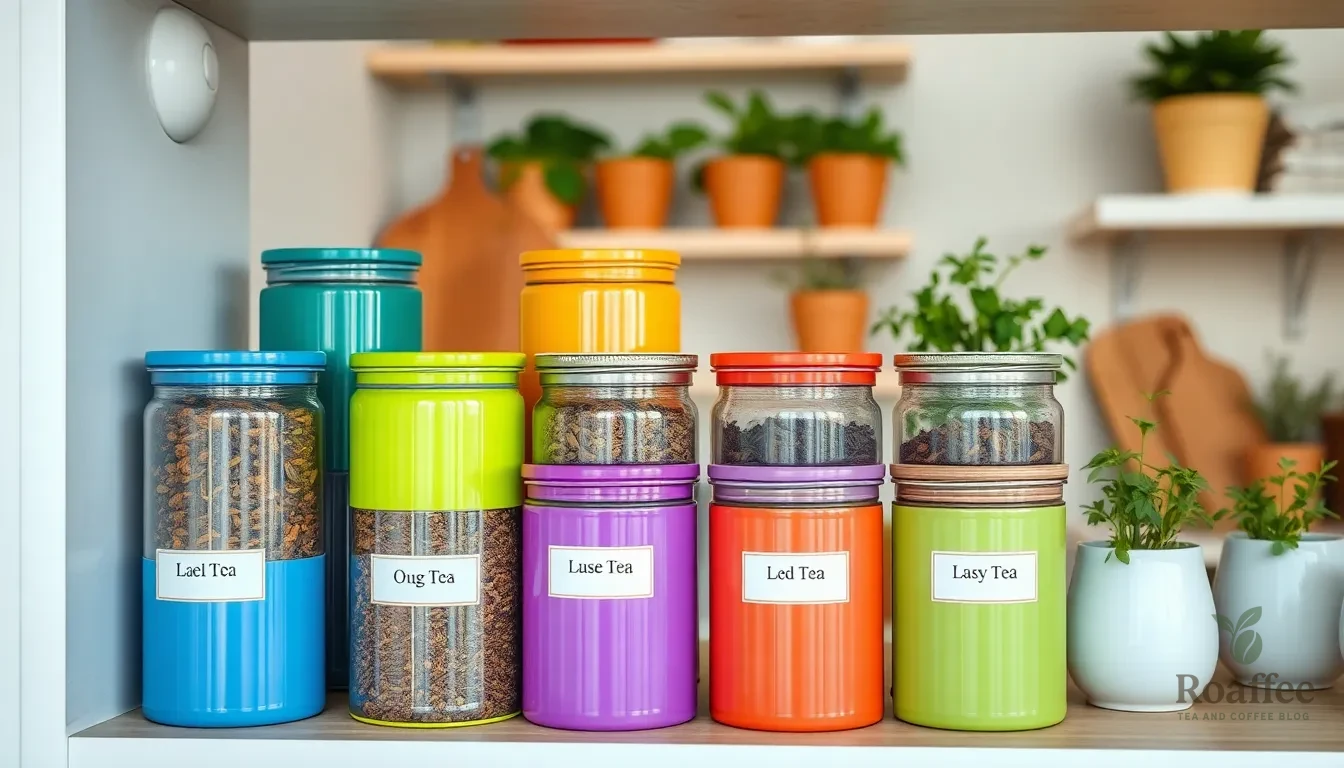
We maintain our loose leaf tea’s exceptional quality through proactive monitoring and systematic storage practices. Our commitment to preserving flavor and aroma requires ongoing attention to storage conditions and container management.
Regular Inspection Tips
We recommend checking our tea collections weekly for changes in aroma, appearance, and signs of moisture that indicate early spoilage. Fresh tea maintains its distinctive scent and vibrant color, while deteriorating tea develops musty odors or faded leaves.
Label each container with the tea type and purchase or opening date to track freshness effectively. This dating system helps us avoid using stale tea and ensures we consume our collection in optimal condition. We create a simple tracking system that allows us to identify which teas need attention first.
Visual inspection reveals important quality indicators we should monitor regularly. Look for clumped leaves that suggest moisture intrusion, unusual discoloration that indicates oxidation, or any visible mold growth that requires immediate disposal. Our nose serves as an excellent quality detector, as tea easily absorbs surrounding odors and loses its characteristic fragrance when compromised.
Refreshing Storage Containers
We replace or refresh our storage containers periodically to ensure airtight seals remain effective over time. Container seals deteriorate with regular use, allowing air and moisture to compromise our tea’s quality gradually.
Repackage tea from bulk foil bags into smaller, sealed canisters for daily use while keeping larger amounts sealed tightly and stored separately. This approach minimizes air exposure for our main supply while providing convenient access to smaller portions. We transfer only what we’ll consume within a few weeks to maintain freshness.
Clean containers thoroughly before introducing new tea batches to prevent flavor contamination from previous contents. Metal canisters, tea caddies, and stainless steel containers lined with foil provide the best protection against air, light, moisture, and odors. We avoid plastic, paper bags, or clear glass jars that allow light or air penetration.
Maximizing Shelf Life
We minimize exposure to air by using appropriately sized containers that limit oxygen contact with our tea leaves. Containers that are too large create excess air space, accelerating oxidation and flavor degradation.
Store our loose leaf tea away from strong-smelling items, as tea easily absorbs surrounding odors that alter its natural taste profile. Kitchen spices, cleaning products, and aromatic foods should remain in separate storage areas from our tea collection.
Maintain stable temperatures between 60°F to 75°F (15°C to 24°C) in cool, dark, and dry locations. We avoid areas prone to temperature fluctuations, such as near stoves, windows, or bathrooms that create condensation and moisture problems.
| Storage Factor | Optimal Condition | Temperature Range |
|---|---|---|
| Storage Temperature | Cool and stable | 60°F to 75°F (15°C to 24°C) |
| Container Type | Opaque, airtight | Metal canisters, tea caddies |
| Inspection Frequency | Weekly monitoring | Check aroma and appearance |
Special consideration applies to Pu-erh tea, which we store differently by allowing slight airflow and aging conditions while protecting from strong odors and moisture. Green teas may benefit from refrigeration in airtight packaging to prevent condensation and moisture intrusion, though we avoid freezer storage that introduces moisture and odor risks.
Conclusion
By implementing these storage strategies we’ve outlined you’ll significantly extend the lifespan of your loose leaf tea collection. Remember that the small effort invested in proper storage pays dividends through consistently flavorful cups and reduced waste.
The key is consistency – establishing good storage habits from the moment you bring new tea home. Whether you’re storing a single canister or managing a large collection proper containers stable conditions and regular monitoring make all the difference.
Your tea deserves the same care you put into brewing it. With these techniques in place you’ll enjoy fresher more vibrant flavors cup after cup while getting the most value from every tea purchase.
Frequently Asked Questions
What are the best containers for storing loose leaf tea?
Airtight glass jars, tin canisters, and vacuum-sealed bags are the most effective storage containers. Glass jars provide visibility and excellent sealing, while tin canisters protect against light and moisture. Vacuum-sealed bags create the most airtight environment for long-term storage. Avoid cardboard boxes, original paper packaging, and plastic containers as these can compromise tea quality.
What temperature should loose leaf tea be stored at?
Store loose leaf tea at stable temperatures between 60°F to 75°F (15°C to 24°C) in a cool location. Avoid areas with temperature fluctuations, as this can cause flavor degradation. Kitchen cabinets away from the stove and pantries are ideal locations that maintain consistent temperatures.
Should I store tea in the refrigerator or pantry?
Pantry storage is generally superior for maintaining tea freshness due to stable conditions. Refrigeration can introduce moisture risks and temperature fluctuations. The only exception is for large quantities of green tea that will take over six months to consume, where refrigeration may be beneficial if moisture is carefully controlled.
How do I prevent different tea types from affecting each other’s flavor?
Use individual airtight containers for each tea type to prevent cross-contamination. Avoid plastic or clear jars that may leak odors. Store strong-flavored teas like Earl Grey separately from delicate teas like white or green varieties. Label each container with the tea type and storage date.
What are the signs that loose leaf tea has gone bad?
Look for visual indicators like faded color, mold growth, clumped leaves, or unusual discoloration. Check for changes in smell – fresh tea losing its distinctive aroma or developing musty, sour odors indicates spoilage. Taste changes include flat or unpleasant flavors. Dispose of any tea showing these signs immediately.
How long can properly stored loose leaf tea last?
With proper storage, black teas can last 3-5 years, oolong teas 2-3 years, and green/white teas 1-2 years. Herbal teas typically maintain quality for 2-3 years. Pu-erh tea can actually improve with age when stored correctly. Always check for signs of spoilage regardless of storage time.
Can I freeze loose leaf tea for long-term storage?
Yes, freezing works well for delicate green and yellow teas when properly done. Vacuum seal the tea to prevent moisture damage and freeze in small portions. Thaw completely before opening to prevent condensation. This method is best for tea you won’t use for several months.
Where should I avoid storing loose leaf tea?
Avoid storing tea near heat sources, in high humidity areas like bathrooms, or near strong-smelling foods. Don’t store tea in direct sunlight, above the stove, or in areas with temperature fluctuations. These conditions can compromise tea quality and introduce unwanted flavors or moisture.

